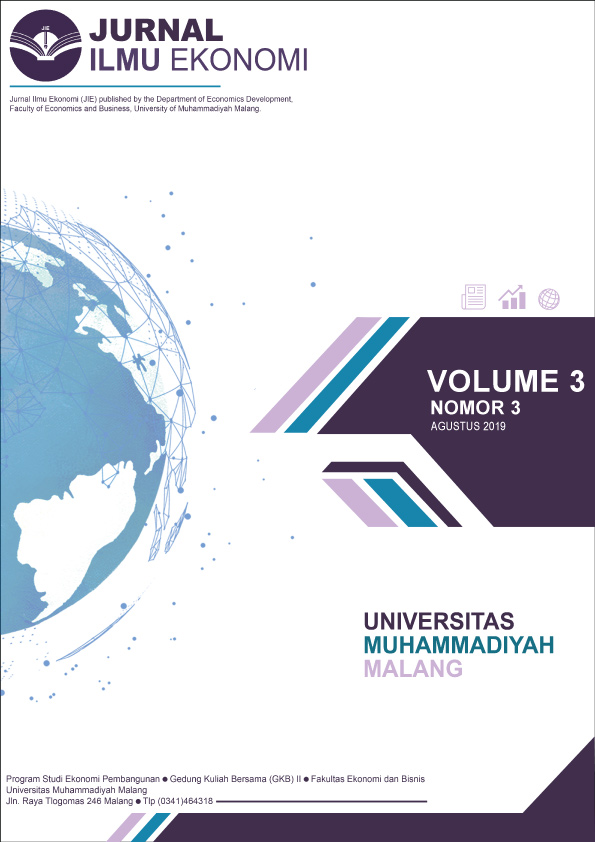ANALISIS EFISIENSI USAHA INDUSTRI TENUN GEDOGAN DI DESA PRINGGASELA KECAMATAN PRINGGASELA KABUPATEN LOMBOK TIMUR
DOI:
https://doi.org/10.22219/jie.v3i3.9029Abstract
The purpose of this study was to analyze the business income of the gedogan weaving industry, analyze the level of business efficiency of the gedogan weaving industry, and analyze the marketing channels of the gedogan weaving industry, and analyze the marketing channels of the gedogan weaving industry in Pringgasela Village, Pringgasela District, East Lombok Regency. The method used in this research is descriptive with the unit of analysis, which is a craftsman who works on the gedogan weaving industry in Pringgasela Village. In this study using a sample of 45 respondents. The data obtained were analyzed using income analysis, R / C ratio analysis and descriptive analysis. The results of this study indicate that the average income received per month amounted to Rp936,543.17 with an R / C ratio of 1.88. The marketing channel taken by craftsmen through two channels, namely channel one, the craftsman directly sells the products to the final consumer and the channel of the two craftsmen through the retailer then to the final consumer. The obstacles faced by craftsmen are marketing difficulties (52.00%), capital (34.00%) and raw materials (14.00%)
Downloads
References
Arifin, Z. (2011) “Analisis Spasial Industi Kecil Dan Menengah Di Propinsi Nusa Tenggara Timur,” Jurnal Ekonomi Pembangunan, 9(2), hal. 156–173.
Arikunto, S. (2010) Prosedur Penelitian : Suatu Pendekatan Praktek. Jakarta: Rineka Cipta.
Mahabirama, A. K. (2013) “Analisis Efisiensi dan Pendapatan Usahatani Kedelai di Kabupaten Garut Provinsi Jawa Barat,” Jurnal Aplikasi Manajemen, Vol.11, Juni: hal. 197–206.
Nuraini, I. (2009) “Model Pengembangan Industri Manufaktur di Kota Malang,” Ekonomi Pembangunan.
Ramadani, A. (2017) “Analisis Efisiensi Usaha Mikro Kecil Menengah Gula Merah Di Desa Sumberingin Kecamatan Sanankulon Kabupaten Blitar,” Jurnal Ilmu Ekonomi, Volume 1, hal. 44–60.
Sari, N. P. (2018) “Pengembangan Usaha Mikro, Kecil, dan Menengah Melalui Fasilitasi Usaha Pembuatan Dupa,” Jurnal Studi Kasus Inovasi Ekonomi, 03(01), hal. 17–20.
Sarina (2012) “Analisis Pendapatan Dan Efisiensi Usaha Pengolahan Teh Kering Pt. Agrotea Bukit Daun Kabupaten Rejang Lebong. Vol.10 No 2, Desember 2012, hal. 23–27.
Yuli, S. B. C. (2006) “Analisis Perubahan Lingkungan Terhadap Kompetensi Usaha (Studi pada Pengusaha Makanan dan Minuman Skala Kecil dan Menengah di Kabupaten Malang dan Pasuruan),” Humanity, 1(2), hal. 106–116.
Zuhroh, I., Br, A. dan Kurniawati, E. T. (2014) “Pendampingan Pengembangan Usaha Warung Makan,” Jurnal Dedikasi, 11, hal. 46–55.
Downloads
Published
How to Cite
Issue
Section
License
Copyright (c) 2019 Jurnal Ilmu EKonomi JIE

This work is licensed under a Creative Commons Attribution-ShareAlike 4.0 International License.
Authors who publish with this journal agree to the following terms:
- For all articles published in the JIE (Jurnal Ilmu Ekonomi), copyright is retained by the authors. Authors give permission to the publisher to announce the work with conditions. When the manuscript is accepted for publication, the authors agree to the automatic transfer of non-exclusive publishing rights to the publisher.
- Authors retain copyright and grant the journal right of first publication with the work simultaneously licensed under a Creative Commons Attribution-NonCommercial-ShareAlike 4.0 International License that allows others to share the work with an acknowledgement of the work's authorship and initial publication in this journal.
- Authors are able to enter into separate, additional contractual arrangements for the non-exclusive distribution of the journal's published version of the work (e.g., post it to an institutional repository or publish it in a book), with an acknowledgement of its initial publication in this journal.
- Authors are permitted and encouraged to post their work online (e.g., in institutional repositories or on their website) prior to and during the submission process, as it can lead to productive exchanges, as well as earlier and greater citation of published work (See The Effect of Open Access).
This is an open access article and licensed under a Creative Commons Attribution-NonCommercial-ShareAlike 4.0 International License








